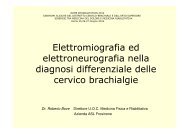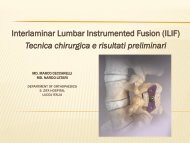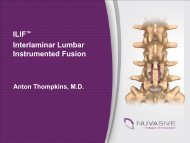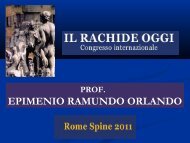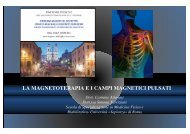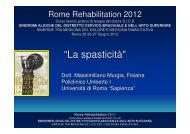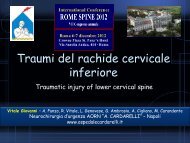Lumbar Facet Joint Replacement
Lumbar Facet Joint Replacement
Lumbar Facet Joint Replacement
Create successful ePaper yourself
Turn your PDF publications into a flip-book with our unique Google optimized e-Paper software.
Rome Spine 2011<br />
THE SPINE TODAY<br />
International Congress<br />
Rome 6-7th December 2011<br />
<strong>Lumbar</strong><br />
<strong>Facet</strong> <strong>Joint</strong> <strong>Replacement</strong><br />
Prof. Dr. Karin Büttner-Janz<br />
Past President<br />
International Society for the Advancement<br />
of Spine Surgery<br />
Director of Orthopaedic Clinic<br />
Vivantes Hospital im Friedrichshain<br />
+49 30 130 23 1306<br />
Director of Traumatologic and Orthopaedic Clinic<br />
Vivantes Hospital Am Urban<br />
+49 30 130 22 6201<br />
Vivantes Hospital Company, Berlin – Germany<br />
karin.buettner-janz@vivantes.de<br />
karin.buettner-janz@vivantes.de
Motion Retaining Devices for:<br />
Repair, Preservation or Improvement of<br />
Function - including Motion<br />
of the Cervical and <strong>Lumbar</strong> Functional Spinal Unit<br />
• <strong>Lumbar</strong> Total Disc <strong>Replacement</strong><br />
• Cervical Total Disc <strong>Replacement</strong><br />
• Nucleus <strong>Replacement</strong><br />
• Posterior Dynamic Stabilisation / Screws + Connectors<br />
• Posterior Dynamic Stabilisation / <strong>Facet</strong> <strong>Joint</strong> <strong>Replacement</strong><br />
• Posterior Dynamic Stabilisation / Interspinous Implants<br />
• Implant Combination
1. Basics of <strong>Lumbar</strong> <strong>Facet</strong> <strong>Joint</strong>s<br />
2. Classification of <strong>Facet</strong> <strong>Joint</strong> <strong>Replacement</strong><br />
3. Clinical Results<br />
AGENDA<br />
4. <strong>Facet</strong> <strong>Joint</strong> <strong>Replacement</strong> (FJR) after<br />
Total Disc <strong>Replacement</strong> (TDR)
Anatomy and Biomechanics<br />
“Three-<strong>Joint</strong>-Complex”<br />
Spinal Motion Segment<br />
[= Functional Spinal Unit]<br />
– 1 Disc<br />
– 2 <strong>Facet</strong> <strong>Joint</strong>s
Location based <strong>Facet</strong> <strong>Joint</strong> Function<br />
Cervical Spine:<br />
• Lowest transmitted loads of the spine<br />
• Most freedom in lateral bending, extension<br />
and axial rotation<br />
<strong>Lumbar</strong> Spine:<br />
• <strong>Facet</strong>s are larger, more centrally located, and<br />
almost parallel along the sagittal plane<br />
• Lateral bending is limited<br />
• Stop for hyper-extension and axial rotation<br />
Variation in facet orientation and location within vertebral regions<br />
(White and Panjabi, Clinical Biomechanics of the Spine, 2 nd Ed.)
<strong>Facet</strong> Morphology<br />
<strong>Facet</strong> Angle<br />
<strong>Facet</strong> Curvature
<strong>Facet</strong> <strong>Joint</strong> Degeneration<br />
Grade I Grade II<br />
Grade III Grade IV<br />
[Fujiwara, et al., Spine (2000) 25:23, pp 3036–3044]<br />
Grade I Grade II<br />
Grade III Grade IV<br />
[Tischer, T. et al., Eur. Spine J. (2006) 15: 308–315]<br />
• Grade I: uniformly thick cartilage covers the articular surfaces completely.<br />
• Grade II: cartilage covers the entire surface of the articular process but an<br />
eroded irregular region is evident.<br />
• Grade III: cartilage incompletely covers the articular surfaces with regions<br />
of underlying bone exposed to the joint.<br />
• Grade IV: cartilage is absent except for traces on the articular process.
1. Basics of <strong>Lumbar</strong> <strong>Facet</strong> <strong>Joint</strong>s<br />
2. Classification of <strong>Facet</strong> <strong>Joint</strong> <strong>Replacement</strong><br />
3. Clinical Results<br />
3. FJR after TDR<br />
AGENDA
Classification of <strong>Facet</strong> <strong>Joint</strong> <strong>Replacement</strong> according to<br />
• Design<br />
• Material<br />
(further developed to Büttner-Janz, 2008; In: Motion Preservation Surgery of the Spine)<br />
1. <strong>Facet</strong> Resurfacing / Partial <strong>Facet</strong> <strong>Joint</strong> <strong>Replacement</strong><br />
a) Plastic<br />
b) Metal<br />
c) Combination of metal and plastic<br />
2. Total <strong>Facet</strong> <strong>Joint</strong> <strong>Replacement</strong><br />
a) Plastic<br />
b) Metal<br />
c) Combination of metal and plastic<br />
3. Three <strong>Joint</strong> <strong>Replacement</strong><br />
(<strong>Facet</strong> <strong>Joint</strong> <strong>Replacement</strong> + Disc <strong>Replacement</strong> at same<br />
segment + time)<br />
a) Combination with Nucleus <strong>Replacement</strong><br />
b) Combination with Total Disc <strong>Replacement</strong><br />
(implantation via ventral, lateral or dorsal approach)
Examples<br />
Classification of <strong>Facet</strong> <strong>Joint</strong> <strong>Replacement</strong> according to<br />
• Design<br />
• Material<br />
(further developed to Büttner-Janz, 2008 - In: Motion Preservation Surgery of the Spine)<br />
1. <strong>Facet</strong> Resurfacing / Partial <strong>Facet</strong> <strong>Joint</strong> <strong>Replacement</strong><br />
Does not violate the pedicles = Minimal invasive surge<br />
a) Plastic<br />
b) Metal<br />
c) Combination of metal and plastic<br />
ZYRE <strong>Facet</strong> Implant System FENIX Resurfacing System Zyga GLYDER Device
Examples<br />
Classification of <strong>Facet</strong> <strong>Joint</strong> <strong>Replacement</strong> according to:<br />
• Design<br />
• Material<br />
(further developed to Büttner-Janz, 2008; In: Motion Preservation Surgery of the Spine)<br />
2. Total <strong>Facet</strong> <strong>Joint</strong> <strong>Replacement</strong><br />
Violates the pedicles, vertebrae, laminae, muscles and ligaments<br />
= Maximale invasive surgery<br />
a) Plastic<br />
b) Metal<br />
c) Combination of metal and plastic<br />
TFAS TFAS-LS ACADIA<br />
<strong>Facet</strong> <strong>Replacement</strong> System<br />
TOPS System<br />
TOP SP System is<br />
30% smaller device.<br />
Not yet implanted in human.
Examples<br />
Classification of <strong>Facet</strong> <strong>Joint</strong> <strong>Replacement</strong> according to:<br />
• Design<br />
• Material<br />
(further developed to Büttner-Janz, 2008; In: Motion Preservation Surgery of the Spine)<br />
2. Total <strong>Facet</strong> <strong>Joint</strong> <strong>Replacement</strong><br />
Violates the pedicles, vertebrae, laminae, muscles and ligaments!<br />
= Maximale invasive surgery<br />
a) Plastic<br />
b) Metal<br />
c) Combination of metal and plastic<br />
IN VITRO:<br />
Auxiliary <strong>Facet</strong> System (AFC)<br />
Yann Philippe Charles et al.:<br />
SPINE 2011 Volume 36, Number 9, pp 690–699<br />
(2 angulated rods, polyaxial connectors, crosslink,<br />
4 pedicel screws – all metal components)
Examples<br />
Classification of <strong>Facet</strong> <strong>Joint</strong> <strong>Replacement</strong> according to:<br />
• Design and<br />
• Material<br />
(further developed to Büttner-Janz, 2008; In: Motion Preservation Surgery of the Spine)<br />
3. Three <strong>Joint</strong> <strong>Replacement</strong><br />
(<strong>Facet</strong> <strong>Joint</strong> <strong>Replacement</strong> + Disc <strong>Replacement</strong> at same segment + time)<br />
Violates the disc, pedicles, vertebrae, laminae, muscles, ligaments!<br />
= „Most maximale“ invasive surgery<br />
a) Combination with Nucleus <strong>Replacement</strong><br />
b) Combination with partial oder Total Disc <strong>Replacement</strong><br />
(disc implantation via ventral, lateral or dorsal approach)<br />
Inlign Total Motion Segment
1. Basics of <strong>Lumbar</strong> <strong>Facet</strong> <strong>Joint</strong>s<br />
2. Classification of <strong>Facet</strong> <strong>Joint</strong> <strong>Replacement</strong><br />
3. Clinical Results<br />
3. FJR after TDR<br />
AGENDA
<strong>Facet</strong> Recurfacing:<br />
• Painful Degeneration of <strong>Facet</strong> <strong>Joint</strong> (after Denervation)<br />
• Post TDR <strong>Facet</strong> <strong>Joint</strong> Disease<br />
• Inflammation of <strong>Facet</strong> <strong>Joint</strong><br />
• Cyst of <strong>Facet</strong> <strong>Joint</strong><br />
Indications<br />
• “<strong>Facet</strong> Kicking Syndrome” (after Fusion, TDR - L.Pimenta)<br />
• (Degenerative Spondylolisthesis)
Zyre <strong>Facet</strong> Implant System (2007)<br />
With / without bone resection.<br />
Lauryssen et al. 2008: Minimal-invasiv surgery as stand alone<br />
device or in combination with other motion retaining devises.<br />
No clinical data available<br />
FENIX Resurfacing System (2007)<br />
van de Kelft 2009: 8 patients, mean age 53 y<br />
After 1 year 6 patients satisfied, still motion at operated level.<br />
ODI 48 preop. 18 postop., VAS 7.2 preop. 2.5 postop.<br />
1 case with spinal canal revision surgery at upper adjacent level<br />
1-2011: 15 patients operated, 2-years follow up, CE-approval
Zyga GLYDER Device (2010)<br />
Surgical Goals:<br />
• Reduced pain or pain-free facet joint<br />
• Maintains natural facet joint motion<br />
• Maintains native anatomy<br />
• Maintains option for Total <strong>Facet</strong> <strong>Joint</strong><br />
<strong>Replacement</strong><br />
• Maintains option for fusion surgery<br />
Pt/Ir marker Pt/Ir marker<br />
• PEEK polymer with Platinum / Iridium Marker<br />
• Teeth on backside to prevent dislocation<br />
• Small size: 9 x 11 mm (L12 and L23)<br />
• Large size: 12 x 14 mm (L3-S1)<br />
Not yet CE approved<br />
L. Pimenta/Brasilia
Zyga GLYDER Device<br />
Results of Luiz Pimenta:<br />
• 18 patients (mean age 44 years)<br />
– post TDR facet joint disease<br />
– facet joint degeneration/disease<br />
– kicking facet syndrome (after fusion)<br />
• Indication: Pain- at preop facet injection<br />
• Incl. double level cases<br />
• Surgical duration ≈ 98 min<br />
• Follow-up ≈ 6 months
Zyga GLYDER Device<br />
Hans Jörg Meisel/Germany:<br />
• 3 patients<br />
Surgery Dec 1st 2011
Zyga GLYDER Device
Indications<br />
Total <strong>Facet</strong> <strong>Joint</strong> <strong>Replacement</strong>:<br />
• Symptomatic Spinal Canal Stenosis with<br />
indication for facet joint removal
TOPS (2004)<br />
5-year follow up‘s available with successful results.<br />
After adaptation to smaller implant further surgeries are planned.<br />
Company was re-bought.
TFAS (2005)<br />
Not any more on market.<br />
Company was bought by another company.<br />
ACADIA (2005)<br />
Since 2009 US Pivotal Study.<br />
Castellvi (2009): 106 patients, mean age 60 years (34-82):<br />
After 12 postop months ODI improved 79%,<br />
back pain 53%, leg pain 67%.<br />
No re-operation, no implant problem.<br />
Company was bought by another company.
TFAS – Case Report<br />
Case 1<br />
Case 2<br />
Stem fracture after total facet replacement<br />
in the lumbar spine: a report<br />
of two cases and review of the literature<br />
Daniel K. Palmer, BS, Serkan Inceoglu,<br />
PhD, Wayne K. Cheng, MD<br />
The Spine Journal 11 (2011) e15–e19<br />
Case 1: A 55-year-old man with a body mass index (BMI) of 40 underwent<br />
total facet replacement at L4–L5 for Grade 1 spondylolisthesis with stenosis.<br />
After 9 months of pain relief, he experienced gradually increasing pain and<br />
radiographs showed a broken stem.<br />
Case 2: A 60-year-old woman with a BMI of 31 underwent total facet<br />
replacement at L4–L5 for Grade 1 spondylolisthesis with stenosis. She<br />
experienced stem fracture 27 months postoperatively.<br />
Treatment: Trans-psoas interbody fusion<br />
surgery
Indications<br />
“Three <strong>Joint</strong> <strong>Replacement</strong>”:<br />
• Includes indications of TDR + FJR
Inlign Total Motion Segment (2008)<br />
Study with 50 patients was started.<br />
Results are unknown.
1. Basics of <strong>Lumbar</strong> <strong>Facet</strong> <strong>Joint</strong>s<br />
2. Classification of <strong>Facet</strong> <strong>Joint</strong> <strong>Replacement</strong><br />
3. Clinical Results<br />
3. FJR after TDR<br />
AGENDA
TDR: ►<strong>Facet</strong> <strong>Facet</strong> <strong>Joint</strong> <strong>Joint</strong> Degeneration<br />
Kube et al. SAS 2006:<br />
Outcome in lumbar disc arthroplasty is related to grade of facet arthropathy.<br />
Chan Shik Shim et al. SPINE 2007:<br />
• 57 patients >3 years follow up (MRI: 52 patients)<br />
• Charité 33, Prodisc 24<br />
• Both groups with facet joint degeneration<br />
Park et al. SPINE 2008:<br />
• Prodisc 46 patients min. 2 years follow up<br />
• MRI and CT preop and 2 years F/U: 29.3% progressive facet degeneration<br />
Siepe et al. SPINE 2010:<br />
• Prodisc 93 patients min. 2 years follow up (Ø 53,4 months)<br />
• X-ray and MRI preop and postop F/U: 20.0% facet joint degeneration (FJD)<br />
• FJD more often at level L5/S1; FJD associated with negative clinical outcome<br />
and lower ROM
► TDR TDR + + <strong>Replacement</strong> of of <strong>Facet</strong> <strong>Facet</strong> <strong>Joint</strong>s <strong>Joint</strong>s<br />
2 years after Charité Artificial Disc:<br />
TFAS LS cementless<br />
(Implantation 09-2008)<br />
Excising of complete pain generator<br />
Alternatively:<br />
Zyga GLYDER Device
Compact total disc: Less facet joint degeneration / disease?<br />
No adjacent level disease?<br />
SL, f: Nucleotomy: 33 years; Charité disc: 34 years; Freedom disc: 38 years<br />
CHARITÉ + FREEDOM<br />
Extension Flexion
<strong>Facet</strong> <strong>Facet</strong> <strong>Joint</strong> <strong>Joint</strong> <strong>Replacement</strong> – – Conclusion and and Questions<br />
1. From clinical point of view the „pain generator“ facet joint is as important as<br />
the intervertebral disc. From anatomical and biomechanical point of view the<br />
lumbar facet joints are to replace. Therefore, carefully diagnostics is needed<br />
before surgery.<br />
2. Surgery: Only a few devices are on market. While the main indication for<br />
total facet joint replacement is a symptomatic spinal canal stenosis, the single<br />
facet joint disease could be the main indication for facet recurfacing. At time of<br />
device implantation thinking on potential revision surgery.<br />
3. Spherical ball and socket type of total discs includes the danger for facet<br />
joint degeneration and disease. Question: Is there an indication for facet<br />
recurfacing preoperatively or postoperatively?<br />
4. Future: At least mid term clinical studies are needed of facet recurfacing and<br />
total facet joint replacement.
Berlin





